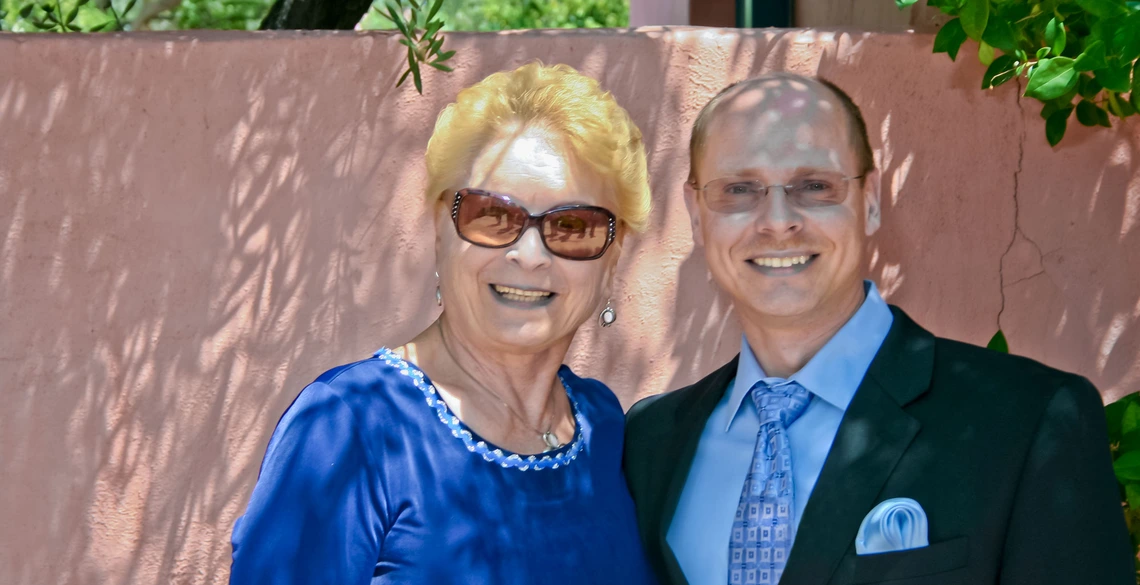UA Engineers Will Create Planetary Rover from Retinal Implant Test Robot
Wolfgang Fink plans to transform remote-controlled implant-testing robotic platform into autonomous rover for planetary exploration.

Maria Keonjian, left, and Wolfgang Fink at the August 2009 reception announcing Fink as the first holder of the Maria and Edward Keonjian distinguished professorship.
When Wolfgang Fink, the recently appointed Edward and Maria Keonjian Distinguished Professor in Microelectronics, establishes his research lab at UA, one of his projects will be to transform a robot that tests retinal implants into a rover for autonomous planetary exploration.
Fink recently moved to UA from the California Institute of Technology, or Caltech, where he and other scientists created a remote-controlled robot that can simulate the “visual” experience and capacity for independent mobility of a blind person with a visual prosthesis such as an artificial retina, which is a silicon chip implanted inside the eyeball and studded with electrodes that directly stimulate retinal nerve cells.
Few people worldwide have been implanted with retinal prostheses, which means that opportunities to test and improve the implants are limited because there is only so much testing that people with implants can be asked to endure.
“How do you approximate what the blind can see with the implant so you can figure out how to make it better?” asked Fink. The answer is a robot called Cyclops. It is more correctly termed a mobile robotic platform, or rover, and is the first device of its kind to simulate what blind people might see with an implant and what degree of independent mobility they can attain.
“We can use Cyclops in lieu of a blind person,” Fink said. “We can equip it with a camera just like what a blind person would have with a retinal prosthesis, and that puts us in the unique position of being able to dictate what the robot receives as visual input.”
Journey Into Space
Fink’s belief is that it is only a short leap of the imagination – and of hardware and software – to adapt Cyclops for autonomous planetary exploration.
“In its current form, the rover is controlled wirelessly over the Internet – from anywhere in the world – by an operator using a joystick,” Fink said. “The next stage is to make it self-maneuvering.”
Before going extraterrestrial, however, a self-maneuvering rover would be tested as an enhancement to the existing application for blind people. If Cyclops can negotiate its way, without assistance, through a room full of furniture to find a door, then it is likely that a blind person with a retinal prosthesis using the same optical input and subsequent image processing could do the same.
“We have the image-processing algorithms running locally on the robot’s platform, but we have to get it to the point where it has complete control of its own responses,” said Fink. After enhancing the image processing system and guidance software, some re-engineering of the platform itself will make Cyclops ready for off-world exploration.
“Ultimately, the image processing system will work by anomaly detection,” Fink said. “This means that it will search for anomalies – objects or events that deviate from expected norms – or for targets preprogrammed into its software. Then it will have to investigate these targets or anomalies, which means it will have to generate its own commands to navigate toward them.”
As director of the Visual and Autonomous Exploration Systems Research Laboratory, which Fink will set up at UA, he will develop the rover in conjunction with other scientists and engineers in the Lunar and Planetary Laboratory and department of aerospace and mechanical engineering. “I am looking forward to testing it in the desert,” Fink said.

